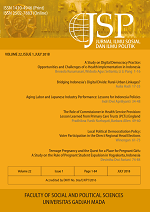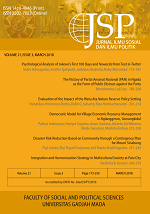Pandemic Crisis in Online Media: Quantitative Framing Analysis on detik.com’s Coverage of Covid-19
Justito Adiprasetio(1*), Annissa Winda Larasati(2)
(1) Department of Mass Communication, Faculty of Communication, Universitas Padjadjaran, Indonesia
(2) The Graduate School, Universitas Gadjah Mada, Indonesia
(*) Corresponding Author
Abstract
This study shows how detik.com, a pioneer and one of the largest online media companies in Indonesia frames the Covid-19 pandemic crisis. From the 6713 news reports in January, February and March, the most dominant framing of the crisis that appeared in the coverage was attribution of responsibility, followed by frame of human interest, frame of morality, frame of conflict and the last is frame of economic consequences. The quantitative approach was used in this research to ensure that systematic analysis and non-arbitrary procedures can be carried out on large amounts of data. This study offered a better understanding on of how online media framed the crisis during the pandemic. The results of this study indicate that the frame of attribution of responsibility is not only the most widely used by detik.com, but also the most dominant when the government is the main source of the news. The form of attribution of responsibility in times of crisis tends to be stronger in the realm of government because crisis events are widespread, forming an experience felt at the national level. As a result, crisis events have the potential to become political symbols used in framing various debates regarding a policy in the long run. The average tone of news towards the government from January to March was positive, although it gradually became more negative.
Keywords
Full Text:
PDFReferences
Abeysinghe, S., & White, K. (2010). Framing Disease: The Avian Influenza Pandemic in Australia. Health Sociology Review: The Journal of the Health Section of the Australian Sociological Association, 19(3), 369–381.
Abeysinghe, S., & White, K. (2011). The avian influenza pandemic: Discourses of risk, contagion and preparation in Australia. Health, Risk & Society Health, Risk & Society, 13(4), 311–326.
Adiprasetio, J. (2019). Kekalahan Jurnalisme di Hadapan Pasar dan Pemasaran Daring. In Suryana, A & et al (Eds.), Eksistensi Promosi di Era Digital (pp. 9–21). Bandung: Bitread.
Adiprasetio, J. (2020a). Covid-19: Saat Ini Kita Membutuhkan Paranoia, Lebih dari Kapanpun. Retrieved May 24, 2020, from Remotivi.id website: https://remotivi. or.id/amatan/578/covid-19-saat-ini-kita- memb ut uhkan-paranoia-leb ih-dari- kapanpun
Adiprasetio, J. (2020b). Under the shadow of the state: Media framing of attacks on West Papuan students on Indonesian online media. Pacific Journalism Review, 26(2), 240–
An, S.-K., & Gower, K. K. (2009). How do the news media frame crises? A content analysis of crisis news coverage. Public Relations Review Public Relations Review, 35(2), 107–112.
Basnyat, I., & Lee, S. T. (2015). Framing of I nfluenza A (H1N1) pand em ic in a Singaporean newspaper. Health Promotion International Health Promotion International, 30(4), 942–953.
Becker, A. B., & Scheufele, D. A. (2011). New Voters, New Outlook? Predispositions, Social Networks, and the Changing Politics of Gay Civil Rights. Socisciequar Social Science Quarterly, 92(2), 324–345.
Ben-Porath, E. N., & Shaker, L. K. (2010). News Images, Race, and Attribution in the Wake of Hurricane Katrina. Journal of Communication, 60(3), 466–490.
Berry, T. ., Wharf-Higgins, J., & Naylor, P. . (2007). SARS wars: an examination of the quantity and construction of health information in the news media. Health Communication, 21(1), 35–44.
Blumer, H. (1971). Social problems as collective behavior. Social Problems, 18(3), 298–306.
Boer, K. M., Pratiwi, M. R., & Muna, N. (2020). Analisis Framing Pemberitaan Generasi Milenial dan Pemerintah Terkait Covid-19 di Media Online. Communicatus, 4(1), 85–104.
Brunken, B. L. (2006). Hurricane Katrina: a content analysis of media framing, attribute agenda setting, and tone of government response. Louisiana State University.
Cho, S. H., & Gower, K. K. (2006). Framing effect on the publics response to crisis: Human interest frame and crisis type influencing responsibility and blame. PUBLIC RELATIONS REVIEW, 32(4), 420–422.
Chong, D., & Druckman, J. N. (2007). Framing Theory. Annual Review of Political Science, 10(1), 103–126. https://doi.org/10.1146/annurev.polisci.10.072805.103054
COVID-19 Map Johns Hopkins Coronavirus Resource Center. (2020). Retrieved May 29, 2020, from https://coronavirus.jhu. edu/map.html
D’Alessio, D., & Allen, M. (2000). Media bias in presidential elections: a meta-analysis. JCOM Journal of Communication, 50(4), 133–156.
D’Angelo, P. (2002). News Framing as a Multiparadigmatic Research Program: A Response to Entman. JCOM Journal of Communication, 52(4), 870–888.
D’Angelo, P., & Kuypers, J. A. (2016). Doing news framing analysis : empirical and theoretical perspectives. II II. Retrieved from https:// nls.ldls.org.uk/welcome.html?ark:/81055/ vdc_100058681739.0x000001
De Vreese, C. H. (2005). Framing Europe: television news and European integration. Amsterdam: Spinhuis.
De Vreese, C. H. (2004). Political Campaigning in Referendums : Framing the Referendum Issue. Retrieved from http://www.myilibrary. com?id=5503
Detenber, B., & McLeod, D. (1999). Framing effects of television news coverage of social protest. Journal of Communication, 49(3), 3–23.
Dijk, T. A. van. (2011). News analysis : case studies of international and national news in the press. New york: Routledge.
Dimitrova, D. V., & Connolly-Ahern, C. (2007). A tale of two wars: Framing analysis of online news sites in coalition countries and the Arab World during the Iraq War. Howard Journal of Communications, 18(2), 153–168. https:// doi.org/10.1080/10646170701309973
Ducharme, J. (2020). News Coverage of Coronavirus in 2020 is Very Different Than it Was For Ebola in 2018. Retrieved May 24, 2020, from Times website: https://time.com/5779872/coronavirus-ebola-news-coverage/
Dunaway, J. (2013). “Media Ownership and Story Tone in Campaign News.” American Politics Research, 41(1), 24–53. https://doi. org/10.1177/1532673X12454564
Endres, K. L. (2004). Help-Wanted Female: Editor & Publisher Frames a Civil Rights Issue. Journalism & Mass Communication Quarterly Journalism & Mass Communication Quarterly, 81(1), 7–21.
Entman, R. M. (1991). Symposium Framing U.S. Coverage of International News: Contrasts in Narratives of the KAL and Iran Air Incidents. JCOM Journal of Communication, 41(4), 6–27.
Entman, R. M. (1993). Framing: Toward Clarification of a Fractured Paradigm. Journal of Communication, 43(4), 51–58.
Entman, R. M. (2007). Projections of power : framing news, public opinion, and U.S. foreign policy. Chicago; London: University of Chicago Press.
Graber, D. ., & Dunaway, J. (2018). Mass media and American politics. Thousand Oaks: California CQ Press.
Haider-Markel, D. P., Delehanty, W., & Beverlin, M. (2007). Media Framing and Racial Attitudes in the Aftermath of Katrina. PSJ Policy Studies Journal, 35(4), 587–605.
Hayati, H. N., & Yoedtadi, M. . (2020). Konstruksi Berita Covid-19 di Kompas.com dan Tribunnews.com. Koneksi, 4(2), 243–250.
Hayes, A. F., & Krippendorff, K. (2007). Answering the Call for a Standard Reliability Measure for Coding Data. Communication Methods and Measures, 1(1), 77–89.
Herlinda, O. (2020). Menimbang Peran Media dalam Menghadapi Epidemi. Retrieved May 24, 2020, from Remotivi.id2 website: https://www.remotivi.or.id/amatan/575/ menimbang-peran-media-dalam- menghadapi-epidemi
Heychael, M., & Rizky, A. P. (2020). Lumpuh dalam Cengkeraman Cukong: Televisi d an Pem be rita an U U Cipta Ke rj a. Retrieved November 9, 2020, from Remotivi.id website: https://www. remotivi.or.id/pantau/643/lumpuh-dalam-cengkeraman-cukong-televisi-dan-pemberitaan-uu-cipta-kerja
Hong, T. (2007). Information Control in Time of Crisis: The Framing of SARS in China- based Newspapers and Internet Sources. CyberPsychology and Behavior, 10(5), 696–699.
Iyengar, S. (1990a). Framing responsibility for political issues: The case of poverty. Polit Behav Political Behavior, 12(1), 19–40.
Iyengar, S. (1990b). The accessibility bias in politics : television news and public opinion. International Journal of Public Opinion Research., 2(1).
Iyengar, S. (1991). Is anyone responsible? : how television frames political issues. Chicago; London: The University of Chicago Press.
Jennings, M. K. (1999). Political Responses to Pain and Loss. The American Political Science Review., 93(1), 1.
Johnson-Cartee, K. S. (2005). News narratives and news framing : constructing political reality. Lanham: Rowman & Littlefield Publishers.
Kim, H., & Cameron, G. (2011). Emotions Matter in Crisis: The Role of Anger and Sadness in the Publics’ Response to Crisis News Framing and Corporate Crisis Response. Communication Research, 38(6), 826–855.
Kiousis, S., McDevitt, M., & Wu, X. (2005). The Genesis of Civic Awareness: Agenda Setting in Political Socialization. JCOM Journal of Communication, 55(4), 756–774.
Krippendorff, K. (2005). Content Analysis : an Introduction to Its Methodology. Thousand Oaks; London; New Delhi: Sage.
Kuypers, J. A. (2005). The art of rhetorical criticism. Boston: Pearson/ Allyn and Bacon.
Lavrakas, P. J. (2011). Encyclopedia of survey research methods. Retrieved from http:// www.credoreference.com/ b ook / sagesurveyr
Lecheler, S., & De Vreese, C. . (2018). Introduction to News Framing Effects Research Theory and Practice. Taylor & Francis.
Loisa, R., Susanto, E. H., Junaidi, A., & Loekman, F. (2019). Media Siber, Aparat, dan Pemberitaan Keberagaman. Jurnal Aspikom: Asosiasi Pendidikan Tinggi Ilmu Komunikasi, 3(6), 1243–1253.
Margianto, J. ., & Syaefullah, A. (2013). Media Online: Pembaca, Laba, dan Etika. Jakarta: AJI Indonesia - Ford Foundation.
McComas, K., & Shanahan, J. (1999). Telling Stories About Global Climate Change: Measuring the Impact of Narratives on Issue Cycles. Communication Research , 26 (1), 30–57. https:/ / doi. org/10.1177/009365099026001003
Merry, M. K. (2015). Framing environmental disaster. [Place of publication not identified]: Routledge.
Miller, A., & Goidel, R. (2009). News organizations and information gathering during a natural disaster: Lessons from Hurricane Katrina. J. Contingencies Crisis Manage. Journal of Contingencies and Crisis Management, 17(4), 266–273.
Neuman, W. R., Just, M. R., & Crigler, A. N. (1994). Common knowledge : news and the construction of political meaning. Chicago; London: University of Chicago Press.
Nijkrake, J., Gosselt, J. F., & Gutteling, J. M. (2015). Competing frames and tone in corporate communication versus media coverage during a crisis. PUBREL Public Relations Review, 41(1), 80–88.
Nisbet, E. C., Hart, P. S., Myers, T., & Ellithorpe, M. (2013). Attitude Change in Competitive Framing Environments? Open-/Closed- Mindedness, Framing Effects, and Climate Change. JCOM Journal of Communication, 63(4), 766–785.
Norris, P., Kern, M., & Just, M. R. (2003). Framing terrorism : understanding terrorist threats and mass media. New York; London: Routledge.
Oktavianti, R. (2016). Reportase dalam Hegemoni Pemerintah dan Media: Studi Kasus Jurnalis Kepresidenan Era Soeharto dan Joko Widodo. Jurnal Komunikasi Indonesia, V(1), 37–47.
Palupi, M. F. T., & Irawan, R. E. (2020). Analisis Framing Pemberitaan Kebijakan Pemerintah Terkait Ketenagakerjaan sebagai Dampak Covid 19 di Kompas.com dan Malaysiakini. Jurnal Representamen, 6(2), 8–22.
Pan, Z., & Kosicki, G. (1993). Framing analysis: An approach to news discourse. Political Comm. Political Communication, 10(1), 55–75.
Papacharissi, Z., & Oliveira, M. de F. (2008). News frames terrorism a comparative analysis of frames employed in terrorism coverage in U.S. and U.K. newspapers. The International Journal of Press, Politics, 13.
Peta Sebaran COVID-19. (2020). Retrieved May 29, 2020, from Gugus Tugas Percepatan Penanganan COVID-19 Indonesia website: https://covid19.go.id/peta-sebaran
Pfau, B. M., Haigh, M., Gettle, M., Donnelly, M., Scoff, G., Warr, D., & Wiffenberg, E. (2015). Combats Unit : Impact On Newspaper And Tone. Journalism & Mass Communication Quarterly , 81 (1), 74–88. https://doi. org/10.1177/107769900408100106
Poindexter, P. M., Smith, L., & Heider, D. (2003). Race and Ethnicity in local Television News: Framing, Story Assignments, and Source Selections. Journal of Broadcasting & Electronic Media, 47(4), 524–536.
Price, V., & Tewksbury, D. (1997). News values and public opinion: A theoretical account of media priming and framing.
Ramli, R., & Latif, D. (2019). Kecenderungan Pilihan Narasumber dan Posisi Berita Demonstrasi pada Surat Kabar Harian Fajar. Komunikologi: Jurnal Ilmiah Ilmu Komunikasi, 16(2), 112–118.
Semetko, H. ., & Valkenburg, P. (2000). Framing European politics: a content analysis of press and television news. Journal of Communication, 50(2), 93–103.
Shoemaker, P. J., & Reese, S. D. (2014). Mediating the message in the 21st century a media sociology perspective. New York & London: Routledge.
Tankard, J..(2001). The empirical approach to the study of media framing. In S.. Reese, A.. Grant, & O.. Gandy Jr (Eds.), Framing public life perspectives on media and our understanding of the social world (pp. 95–106). New York & London: Routledge.
Waldman, P., & Devitt, J. (1998). Newspaper Photographs and the 1996 Presidential Election:TheQuestionofBias.JOURNALISM AND MASS COMMUNICA TION QUARTERLY, 75(2), 302–311.
Article Metrics
Refbacks
- There are currently no refbacks.
Copyright (c) 2021 Jurnal Ilmu Sosial dan Ilmu Politik

This work is licensed under a Creative Commons Attribution-NonCommercial-NoDerivatives 4.0 International License.






















